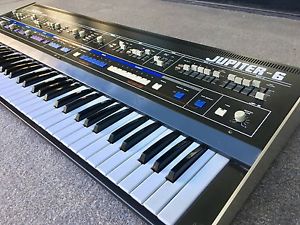Description
| Condition: | Used: An item that has been used previously. The item may have some signs of cosmetic wear, but is fully operational and functions as intended. This item may be a floor model or store return that has been used. See the seller’s listing for full details and description of any imperfections. See all condition definitions- opens in a new window or tab ... Read moreabout the condition | Brand: | Roland |
| Model: | Jupiter 6 | Type: | Keyboard Synthesizer |
| Features: | Sequencer, Arpeggiator, Pitch wheel | Number of Keys: | 61 |
| Inputs / Outputs: | MIDI (DIN) In | UPC: | 9786138719618 |
This keyboard is in perfect working condition, rarely used in a smoke free studio. Sold AS IS, NO RETURNS ACCEPTED. Roland Jupiter-6 From Wikipedia, the free encyclopedia Jupiter-6 Roland Jupiter-6 Manufacturer Roland Dates 1983 - 1985 Price US$2995 UK£2250 JP¥490,000 Technical specifications Polyphony 6 voices Timbrality 2 Oscillator 2 VCOs per voice LFO 2, 1 in LH control section (sine) / 1 programmable, sine/triangle/sawtooth/square Synthesis type Analog Subtractive Filter 1 resonant multi-mode (lowpass/bandpass/hipass) filter Attenuator 2 ADSR Aftertouch expression No Velocity expression No Storagememory 48 tones/32 patches Effects None Input/output Keyboard 61 keys External control MIDI The Roland Jupiter-6 (JP-6) is a synthesizer manufactured by the Roland Corporation introduced in January 1983. Although introduced as a less expensive alternative to the Roland Jupiter-8, its features include some capabilities not present in the JP-8. The Jupiter-6 is widely considered a workhorse among polyphonic analog synthesizers, capable of producing a wide variety of sounds, such as ambient drones, pads, lead synthesizer lines, and techy blips and buzzes. It is renowned for its reliability and ease, but with sophisticated programmability. The JP-6 has 12 analog oscillators (2 per voice), and is bitimbral, allowing its keyboard to be "split" into two sounds - one with 4 voices, and one with the remaining 2 voices (either "Split 4/2" or "Split 2/4" mode). "Whole Mode" is also available, dedicating all 6 voices to single (monotimbral) sound across the entire keyboard. Available waveforms include sawtooth, triangle, variable width pulse, square, and noise. Unusually, the JP-6 allows simultaneous selection of any or all of the waveforms in each of its two oscillator banks, an option not found on the JP-8. Oscillator sync and cross modulation are also available. "Unison Mode" allows all 12 oscillators to be triggered simultaneously by depressing a single key. Unison Mode can also be played polyphonically, with the number of oscillators triggered by each key determined by the number of keys held down. The JP-6 was among the first electronic instruments (alongside the Roland JX-3P and the Sequential Circuits Prophet-600) to feature MIDI, then a brand new technology. Sequential CEO Dave Smith demonstrated MIDI by connecting the Prophet to a Jupiter-6 during the January, 1983 Winter NAMM Show.[1] Europa, a popular firmware upgrade available from Synthcom Systems, adds a wide array of modern enhancements to the instrument's MIDI implementation, user interface, patch memory, and most especially its arpeggiator, turning the Jupiter-6 into a contemporaneously adaptable instrument and unique composition tool. Notable users[edit] Blur Chemical Brothers [2] Devo [3] Dubstar Greg Ham of Men at Work [4] Human League [5] Inner City Julio Bashmore King Crimson Lux Voltaire Mike O' Donnell and Junior Campbell (First two series of the British children's television programme Thomas & Friends) [6] Orbital [7] Orchestral Manoeuvres in the Dark Rob Preuss of The Spoons [8] Rhythm Plate The Unicorns Thomas Gandey Vangelis [9] XRY |
